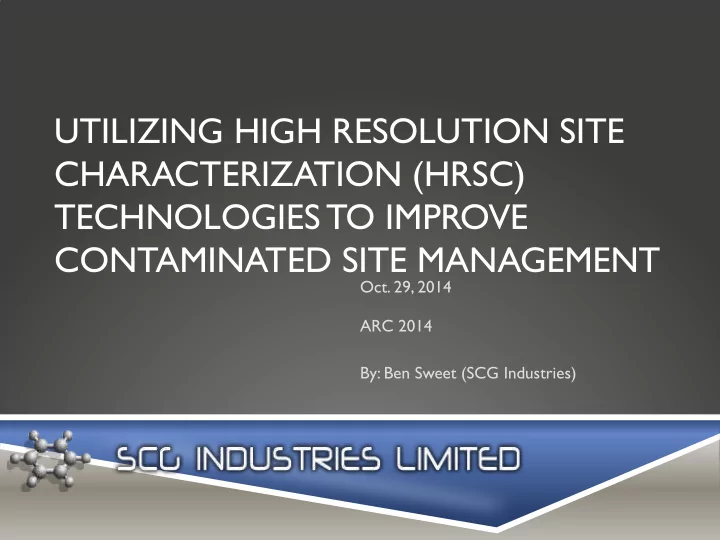

UTILIZING HIGH RESOLUTION SITE CHARACTERIZATION (HRSC) TECHNOLOGIES TO IMPROVE CONTAMINATED SITE MANAGEMENT Oct. 29, 2014 ARC 2014 By: Ben Sweet (SCG Industries)
OUTLINE Definition & Context Case Study I. III. What is HRSC? How does it come together? I. I. Scientific Paradigm HRSC tools utilized II. II. HRSC Interpretation & Results III. II. Questions/Discussion IV. HRSC Tech. benefits I. Technologies II. Data Interpretation III. Best Management Practice IV.
HRSC – DEFINITION USEPA, 2013 “High-resolution site characterization (HRSC) strategies and techniques use scale- appropriate measurements and sample density to define contaminant distributions, and the physical context in which they reside, with greater certainty, supporting faster and more effective site cleanup.” SCALE & EXTENT DATA D&D
NEW SCIENTIFIC PARADIGM The Fourth Paradigm and “BIG DATA” Volume 1 Velocity 1 Variety 1 Variability 1 Complexity 1 “It’s about technology changing the world, and science taking advantage of it, to do more to do better.” – Rhys Francis (Gray, 2007) How do we capitalize on the evolution to improve contaminated site management? 1 SAS Institute Inc., 2014
HRSC TOOLS – IMPROVING THE SCIENCE Relevant at all stages Site-specific Appropriate Scale and Extent Data density & diversity Real-time data - Direct imaging Collaborative data Minimize site impacts & Infrastructure Actionable information Reduce uncertainty – increase cost effectiveness
HRSC – TECHNOLOGIES HRSC employs innovative technologies to achieve a clearer understanding of contaminated site dynamics leading to more cost- effective management solutions. In-situ, direct image probing devices. EC – Electric Conductivity HPT – Hydraulic Profiling Tool MIP – Membrane Interface Probe LIF – Light Induced Fluorescence Utilize down-hole probes on the end of hollow drill rods. Connect with an umbilical to surface. Vertex Environmental, 2014. All vertically log data with depth. Confirmation sampling. Geoprobe, 2014. Dakota Technologies, 2012.
EC – ELECTRIC CONDUCTIVITY PROBE The EC tool measures soil conductivity. This information is used to characterize site stratigraphy and groundwater TDS (Total Dissolved Solids). General Soil Conductivity Range The probe operates by running a known current through the soil and measuring the voltage, this is used to calculate conductivity in mS/m (milli-Siemens per meter.) LSU AgCenter, 2011.
EC – ELECTRIC CONDUCTIVITY PROBE Example of an EC vertical delineation. Conductivity is measured in the left hand readout and penetration rate on the right. Readout indicative of a tighter material with inter- bedded coarse lenses and a general coarsening after ~30m. Delineation of lithology and mapping of ionic/saline contaminants. Geoprobe, 2008. Wikipedia, 2009.
HPT – HYDRAULIC PROFILING TOOL The HPT measures changes in the required pore entry pressure of the stratum. This correlates with media permeability and allows for vertical profiling of hydrostratigraphic information. The HPT delivers water to the subsurface through the probe head. A transducer in the probe measures the required injection pressure and hydrostatic pressure. Geoprobe, 2014.
HPT – HYDRAULIC PROFILING TOOL Injection pressure relates directly to formation permeability and hydraulic conductivity in the saturated zone. HPT can calculate the approximate water table elevation by measuring the hydrostatic pressure. EC and HPT tandem use. Delineation of ionic plumes and stratigraphy. Migration pathways. Remediation planning. Geoprobe, 2010.
MIP – MEMBRANE INTERFACE PROBE The MIP is an in-situ sampling device that can vertically delineate the distribution of sorbed, vapour and dissolved phase Volatile Organic Compounds (VOCs). MIP utilizes a semi-permeable membrane and an unreactive carrier gas to move VOCs up hole to above ground sampling devices. Geoprobe, 2014
MIP – MEMBRANE INTERFACE PROBE Sampling Devices: FID, PID, XSD MIP is a mobile, in-situ gas detection unit. Similar to GC, but no speciation. Delineation of dissolved plumes. Wide range of contaminants. Sampling – remediation. Geoprobe, 2014. Geoprobe, 2014.
LIF – LIGHT INDUCED FLUORESCENCE Utilizes in-situ fluorescence spectroscopy to locate Free Phase Petroleum Hydrocarbons. Dakota Technologies UVOST. Operation is based on two principles: Fluorescence and PAH partitioning Dakota Technologies, 2014 Dakota Technologies, 2014.
LIF – LIGHT INDUCED FLUORESCENCE Provides semi-quantitative and qualitative data. Delineation of free phase petroleum products. Qualitative petroleum analysis. Recoverability.
INNOVATIVE TOOLS & METHODOLOGIES Other HRSC tools are available. Tailored for the environment, contaminant, metric. HRSC is not just a suite of technologies – involves strategies, methodologies and management/field practices. Tools: CPT DPT “Grab” Sampling Passive Diffusion Samplers Multi-level GW Systems Geophysical Surveys Solinst, 2013. Dakota Technologies, 2014. USEPA, 2014.
DATA INTERPRETATION Qualified interpretation is paramount. Context. Correlation & Integration. Accuracy & Precision. Workable & Compatible.
BEST MANAGEMENT PRACTICES The use of HRSC is growing in jurisdictions in both Canada and the United States. Support from industry and non-governmental organizations. FCSAP , CCME, USEPA, IRTC, FRTR and both state/provincial regulators support HRSC technologies and strategies. HRSC tools provide value at all stages of the contaminated site management lifecycle.
HOW DOES IT COME TOGETHER? Example of HRSC tool use at a Federal Contaminated Site. Previous characterization and ongoing monitoring. Historic contamination: Release from an underground fuel line - Avgas and Jet fuel. Deep, unconfined aquifer – “Silty-sand”. Three SCG Multi-phase Extraction Systems (MPE) were installed to remediate free phase, vapour phase and sorbed phase petroleum hydrocarbon contamination. DCC, 2013 DCC, 2013
USE OF HRSC TECHNOLOGIES MIP , LIF, HPT used in tandem with EC & Confirmation sampling. Data: Delineation of the dissolved phase plume. Delineation of the LNAPL plume. Hydrogeological dynamics influencing contaminant distribution and mobility. Tools together provide a three dimensional spatial analysis of contaminant mass concentrations, contaminant phase distribution and resident media dynamics. Objectives: Further refinement of the Conceptual Site Model (CSM). Enhance the optimization of current MPE systems. Recommendations for further remediation efforts.
RESULTS SCG’s scope – enhance optimization of MPE and remedial strategy recommendations. LNAPL in smear zone. LNAPL submerged in source zone. LNAPL correlation with relative permeability – recoverability. Targetable recovery locations in 3 dimensional space – optimized MPE operation. Effective recommendations based on evidence, not inference.
QUESTIONS? Look forward to discussion. Feel free to contact us: Mike Campbell: mcampbell@scgindustries.com Ben Sweet: jwbsweet@scgindustries.com THANK YOU.
Recommend
More recommend